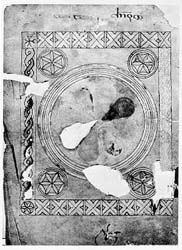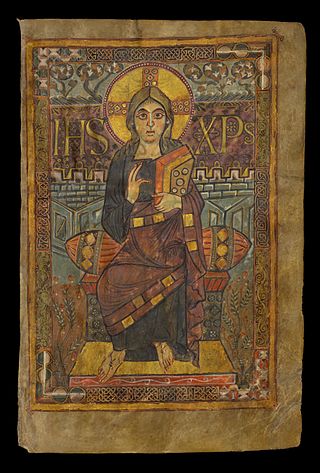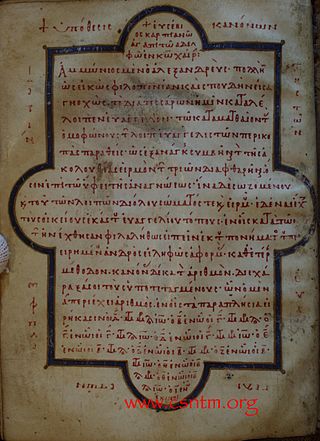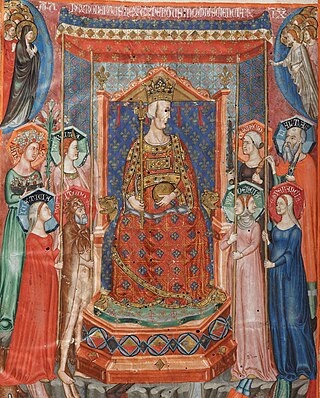
Maaseik is a city and municipality in the Belgian province of Limburg. Both in size and in population, it is the 8th largest municipality in Limburg. The town is the seat of the administrative arrondissement of Maaseik (kieskanton). Internationally, Maaseik is known as the assumed birthplace of the famous Flemish painters Jan and Hubert van Eyck.

The Bobbio Orosius is an early 7th century Insular manuscript of the Chronicon of Paulus Orosius. The manuscript has 48 folios and measures 210 by 150 mm. It is thought to have been produced at the scriptorium of Bobbio Abbey, which was founded by Saint Columbanus in 612. It appears in an inventory of the monastic library done in 1461. The monks gave the manuscript to the Ambrosian Library when it was founded in 1606 by Cardinal Federico Borromeo.

The Echternach Gospels were produced, presumably, at Lindisfarne Abbey in Northumbria around the year 690. This location was very significant for the production of Insular manuscripts, such as the Durham Gospels and the Lindisfarne Gospels. The scribe of the Durham Gospels is believed to have created the Echternach Gospels as well. The Echternach Gospels are now in the collection of France's Bibliothèque Nationale in Paris.

The Godescalc Evangelistary, Godescalc Sacramentary, Godescalc Gospels, or Godescalc Gospel Lectionary is an illuminated manuscript in Latin made by the Frankish scribe Godescalc and today kept in the Bibliothèque nationale de France. It was commissioned by the Carolingian king Charlemagne and his wife Hildegard on October 7, 781 and completed on April 30, 783. The Evangelistary is the earliest known manuscript produced at the scriptorium in Charlemagne's Court School in Aachen. The manuscript was intended to commemorate Charlemagne's march to Italy, his meeting with Pope Adrian I, and the baptism of his son Pepin. The crediting of the work to Godescalc and the details of Charlemagne's march are contained in the manuscript's dedication poem.

British Library, Harley MS 1775 is an illuminated Gospel Book produced in Italy during the last quarter of the 6th century. The text is in Latin and is a mixture of the Vulgate and Old Latin translations. This text is called "source Z" in critical studies of the Latin New Testament.

The Schuttern Gospels is an early 9th century illuminated Gospel Book that was produced at Schuttern Abbey in Baden. According to a colophon on folio 206v, the manuscript was written by the deacon Liutharius, at the order of his abbot, Bertricus.

The La Cava Bible or Codex Cavensis is a 9th-century Latin illuminated Bible, which was produced in Spain, probably in the Kingdom of Asturias during the reign of Alfonso II. The manuscript is preserved at the abbey of La Trinità della Cava, near Cava de' Tirreni in Campania, Italy, and contains 330 vellum folios which measure 320 by 260 mm.

The Abbey of Echternach is a Benedictine monastery in the town of Echternach, in eastern Luxembourg. The abbey was founded in the 7th century by St Willibrord, the patron saint of Luxembourg. For three hundred years, it benefited from the patronage of a succession of rulers, and was the most powerful institution in Luxembourg.
A biblical manuscript is any handwritten copy of a portion of the text of the Bible. Biblical manuscripts vary in size from tiny scrolls containing individual verses of the Jewish scriptures to huge polyglot codices containing both the Hebrew Bible (Tanakh) and the New Testament, as well as extracanonical works.

The Church of Saint Anne is a partly Romanesque, partly Gothic church in Aldeneik, Belgium.

Minuscule 682, ε 157, is a Greek minuscule manuscript of the New Testament, on parchment. Palaeographically it has been assigned to the 11th century. The manuscript has complex contents. Scrivener labelled it by 533e.

Aldeneik Abbey is a former Benedictine abbey in Aldeneik, currently a mainly residential parish of Maaseik, in the province of Limburg in eastern Belgium. It was founded in 728. The Benedictine nuns were replaced by canons in the 10th century. In the 16th century the canons moved to nearby Maaseik, and Aldeneik was abandoned.
The Sainte-Chapelle Gospels or the Sainte-Chapelle Gospel Book is an Ottonian illuminated manuscript now housed in the Bibliothèque nationale de France in Paris as Latin 8851. It is made up of 156 parchment folios, in a 38.5 cm by 28 cm format, making it one of the largest manuscripts of its era. It includes miniatures such as the canon tables, Christ in majesty and the Four Evangelists. It is the work of the Master of the Registrum Gregorii, the most famous illuminator of the Ottonian Renaissance.
The Gregorian Sacramentary is a 10th-century illuminated Latin manuscript containing a sacramentary. Since the 16th century it has been in the Vatican Library, shelfmark Vat. Lat. 3806.

The Trier Gospels is a Gospel book that contains the works and illustration of: Matthew, Mark, Luke, and John. It was copied by two scribes between the years 720 and 740 A.D. in Echternach Abbey The gospel is currently located at Trier Cathedral Treasury.
Jan Van der Stock is a Belgian art historian and exhibition curator. He is a full professor at the University of Leuven, where he lectures on Medieval and Renaissance Arts, Graphic Arts, Iconography, Iconology, and Curatorship. He is the director of Illuminare – Centre for the Study of Medieval Art and holder of the Van der Weyden Chair – Paul & Dora Janssen, the Veronique Vandekerchove Chair of the City of Leuven and the Chair of Medieval Sculpture in the Low Countries. Jan Van der Stock was the husband of Prof. dr. Christiane Timmerman and is the father of Willem and Liza Van der Stock.

The Dendermonde Codex or sometimes called Villarenser Kodex or codex 9 of Dendermonde Abbey, is a valuable manuscript containing the Symphonia harmoniae caelestium revelationum of Hildegard of Bingen.
Illuminare – Centre for the Study of Medieval Art KU Leuven, is a university-led research and documentation centre. It is situated in the University Library in the town of Leuven, Belgium and is accessible to both academics and students. The focus on Medieval and Early Modern Art from the Southern Low Countries in a European perspective is facilitated by both research and doctoral projects that are in turn supported by a vast international network of universities, institutions, and museums.

The Emperor's Bible, also known as Codex Caesareus, Codex Caesareus Upsaliensis or the Goslar Gospels, is an 11th-century illuminated manuscript currently in Uppsala University Library, Sweden. Despite its name, it is not a Bible but a Gospel Book. The book was made in the scriptorium of Echternach Abbey, and is one of four preserved large Gospel Books made there during the 11th century. It was commissioned by Emperor Henry III and donated by him to Goslar Cathedral, where it remained until the Thirty Years' War. It was then lost for about 100 years. Its previous richly decorated cover was also lost at this time at the latest. The book later appeared again in the possession of Swedish diplomat and civil servant Gustaf Celsing the Elder. At the death of his son, it was acquired by Uppsala University.

The Anjou Bible, or Bible Angevine, is an illustrated manuscript created c. 1340 in the court of King Robert I of Naples and Sicily. The Bible consists of 344 folios with two full-page illustrations and over 80 small miniatures, dated initials, and marginal miniatures. The work is considered a masterpiece of Italian literature from the fourteenth century.

















